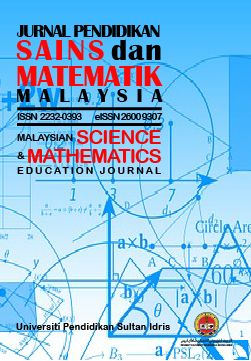Content Analysis on Space Topic in 2021 Revised KSSR Mathematics Textbook
Analisis Kandungan Topik Ruang dalam Buku Teks Matematik KSSR Semakan 2021
DOI:
https://doi.org/10.37134/jpsmm.vol12.2.7.2022Keywords:
textbooks, mathematics, space, content analysis, revised KSSRAbstract
Mathematics textbook is an important source of guidance in mathematics learning and facilitation process (PdPc). This study aims to identify the differences in content presentation, exercises and activity of the topic of Space between revised KSSR standard 5 mathematics textbook version 2021 for National Primary School (SK) and revised KSSR standard 5 mathematics textbook version 2021 for Chinese Type National Primary School (SJKC). The content analysis includes explanation of concept and procedure and application of STEM activity, construct, construct and difficulty levels of exercises and the numbers of exercises. Anecdotal analysis was conducted to display the findings of content presentation narratively, while the exercises and activity are analyzed descriptively. The findings showed that there are differences in mathematics concept delivery and STEM activity application between these two mathematics textbooks, while most of the exercises are at moderate difficulty levels. Therefore, this study is essential in the improvement of textbooks content based on illustration and difficulty levels of exercises to help weaker students in their mathematics learning.
Downloads
References
Abdul Azis, A. & Rosli, R. (2021). Analisis aras kognitif bagi soalan dalam buku teks matematik tahun 4 KSSR semakan. Malaysian Journal of Social Sciences and Humanities (MJSSH), 6(3)146-158. https://doi.org/10.47405/mjssh.v6i3.712
Abdullah, A. H., & Shin, B. (2019). A comparative study of quadrilaterals topic content in mathematics textbooks between Malaysia and South Korea. Journal on Mathematics Education, 10(3), 315-340. https://doi.org/10.22342/jme.10.3.7572.315-340
Acar, D., Tertemiz, N., & Taşdemir, A. (2018). The effects of STEM training on the academic achievement of 4th graders in science and mathematics and their views on STEM training. International Electronic Journal of Elementary Education, 10(4), 505-513. https://doi.org/10.26822/iejee.2018438141
Anggraeni, G. (2021). Recreational mathematics activities to enhance students’ mathematics achievement and learning motivation. In Journal of Physics: Conference Series, 1823(1), 012019. https://doi.org/10.1088/1742-6596/1823/1/012019
Chuen, T. L., & Rosli, R. (2021). The Content Domain Analysis of the Revised KSSR Standard 4 Mathematics Textbook Version 2017. Jurnal Pendidikan Sains Dan Matematik Malaysia, 11(2), 51-66. https://doi.org/10.37134/jpsmm.vol11.2.5.2021
Dollah, M. U., Widjaja, W., Zabit, M. N. M., & Omar, T. Z. Z. (2019). A comparison of values of progress conveyed in mathematics textbooks in Malaysia and Australia. International Journal of Asian Social Science, 9(2), 179–188. https://doi.org/10.18488/journal.1.2019.92.179.188
Hasan, N. H., Sapar, A. A. & Siraj, S. (2020). Analisis kandungan terhadap penampilan kandungan, soalan dan aktiviti buku teks bahasa melayu kurikulum standard sekolah rendah tahap dua: Data anekdot. Jurnal Kurikulum & Pengajaran Asia Pasifik, 8(2), 1-12.
Hassan, K. B., Kamaruddin, H. H., Khalid, R. M., Azman, H. H., & Kasim, C. M. M. (2021). The effectiveness of STEM mentor-mentee programme: Recreational Mathematics among secondary school students. In Journal of Physics: Conference Series, 1882(1), 012044. https://doi.org/10.1088/1742-6596/1882/1/012044
Jerki, A., & K Han, C. G. (2020). Influence of Teaching Experience in Knowledge, Motivation and Implementation of STEM Teaching and Learning: Pengaruh Pengalaman Mengajar dalam Pengetahuan, Motivasi dan Pelaksanaan Pengajaran dan Pembelajaran STEM. Jurnal Pendidikan Sains Dan Matematik Malaysia, 10(2), 45–56. https://doi.org/10.37134/jpsmm.vol10.2.5.2020
Lepik, M., Grevholm, B., & Viholainen, A. (2015). Using textbooks in the mathematics classroom–the teachers’ view. Nordic Studies in Mathematics Education, 20(3-4), 129-156.
Leshota, M. (2020). Teacher–textbook relationships in mathematics in contexts of limited resources. African Journal of Research in Mathematics, Science and Technology Education, 24(3), 375-386. https://doi.org/10.1080/18117295.2020.1847833
Leshota, M. (2020). Teacher–textbook relationships in mathematics in contexts of limited resources. African Journal of Research in Mathematics, Science and Technology Education, 24(3), 375-386. https://doi.org/10.1080/18117295.2020.1847833
Leshota, M., & Adler, J. (2018). Disaggregating a Mathematics Teacher’s Pedagogical Design Capacity. Research on Mathematics Textbooks and Teachers’ Resources: Advances and Issues, 89. https://doi.org/10.1007/978-3-319-73253-4_5
Lusiana, R., & Andari, T. (2019). Developing an algebra textbook based on problem solving to improve student's learning achievement. Al-Jabar: Jurnal Pendidikan Matematika, 10(2), 293-306. https://doi.org/10.24042/ajpm.v10i2.4906
Mahmud, M. S. (2021). Pengintegrasian STEM dalam pengajaran matematik di sekolah rendah: Tinjauan literatur. Jurnal Dunia Pendidikan, 3(3), 179-188.
Mohd Ayub, A. F., & Hock, T. T. (2019). Geometric thinking of Malaysian elementary school students. International Journal of Instruction, 12(1), 1095-1112.
Noh, A., & Rosli, R. (2020). Kandungan ilustrasi pecahan di dalam buku teks matematik tahun 5 KSSR. Jurnal Dunia Pendidikan, 2(3), 231-236.
Overbaugh, R. C., & Schultz, L. (2010). Bloom's Taxonomy, new version.
Rezat, S., Fan, L., & Pepin, B. (2021). Mathematics textbooks and curriculum resources as instruments for change. ZDM–Mathematics Education, 53(6), 1189-1206. https://doi.org/10.1007/s11858-021-01309-3
Singh, P., Yusoff, N. M., & Hoon, T. S. (2020). Content analysis of primary school mathematics textbooks and its relationship with pupils’ achievement. Asian Journal of University Education, 16(2), 15-25. https://doi.org/10.24191/ajue.v16i2.10286
Tan, K. J., Ismail, Z., & Abidin, M. (2018). A comparative analysis on cognitive domain for the Malaysian primary four textbook series. Eurasia Journal of Mathematics, Science and Technology Education, 14(4), 1273-1286. https://doi.org/10.29333/ejmste/82625
Van Den Ham, A. K., & Heinze, A. (2018). Does the textbook matter? Longitudinal effects of textbook choice on primary school students’ achievement in mathematics. Studies in Educational Evaluation, 59, 133-140. https://doi.org/10.1016/j.stueduc.2018.07.005
Wahono, B., Lin, P. L., & Chang, C. Y. (2020). Evidence of STEM enactment effectiveness in Asian student learning outcomes. International Journal of STEM Education, 7(1), 1-18. https://doi.org/10.1186/s40594-020-00236-1
Yang, Y. (2019). A comparative study of the example design in mathematics textbook in Chinese and Singapore junior high schools: Taking Shanghai Education Version and New Express Mathematics Used in Singapore as an example [Master dissertation, Hunan Normal University]. CNKI. https://wap.cnki.net/touch/web/Dissertation/Article/10542-1019672528.nh.html
Yazici, N. (2021). Investigation of use cases of mathematics textbooks in the teaching process from a developmental perspective. Problems of Education in the 21st Century, 79(6), 880-893.
Downloads
Published
Issue
Section
License
Copyright (c) 2022 Guan Yi Tor, Roslinda Rosli

This work is licensed under a Creative Commons Attribution-NonCommercial-ShareAlike 4.0 International License.





